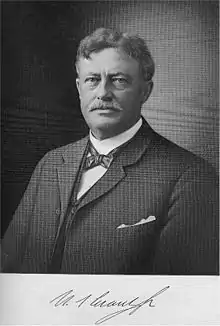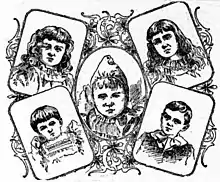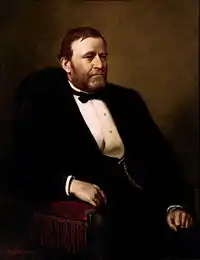Ulysses S. Grant Jr.
Ulysses Simpson "Buck" Grant Jr. (July 22, 1852 – September 25, 1929) was an American attorney and entrepreneur. He was the second son of President Ulysses S. Grant.

Early life and education
Grant was born in Bethel, Ohio, on July 22, 1852. He graduated from Phillips Exeter Academy in 1870, Harvard University in 1874, and Columbia Law School in 1876.
Career
Grant served as personal secretary to his father while he was president, and as Assistant United States Attorney in New York.
Grant then worked in private practice and became wealthy. He partnered in a banking and brokerage firm with Ferdinand Ward. Grant and his father each put $100,000 in the firm and asked veterans and millionaires to invest.
The Grants thought that they would share one-half of the profits from the firm, but realized that Ward was only interested in using the Grant name for his own interests. In 1884, the firm went bankrupt, and the Grants lost everything. Ward was convicted of fraud and served over 6 years in prison. Grant Sr. died the next year; Grant Jr. was never tried.
Real estate
When Buck was back on his feet financially, he bought Merryweather Farm in Salem Center, Westchester County, New York. His wife's health was failing. Grant's mother suggested moving to California. His younger brother, Jesse Root Grant, was already living in San Diego. The Grants moved into a three-story house in San Diego in 1893.
Grant set up a law practice, then gave it up to invest in real estate. He purchased property throughout San Diego. In 1895, he bought the Horton House hotel. He wanted to run the hotel and name it after his father. In 1905, he razed the old hotel and built a new one, the U.S. Grant Hotel, in 1910. San Diego voters helped finance $700,000 for the $1.5 million needed to construct the hotel after Grant lacked the funds to do so.[1] During his time in San Diego, Grant became a close associate of Charles T. Hinde, E.S. Babcock, and John D. Spreckels. Hinde and Grant served on the boards of directors of multiple banks and invested in many companies and business ventures together.
Grant continued to speculate in real estate. He also became a leading citizen, who pushed for the creation of a city park, that would become Balboa Park. Grant was a delegate-at-large for California at the Republican National Conventions in 1896 and 1900. He was also an elector for California in the 1904 and 1908 presidential elections (see U.S. Electoral College).
Personal life

In 1880, Grant married Fannie Josephine Chaffee (1857–1909), daughter of Jerome B. Chaffee, U.S. Senator from Colorado. They had five children: Miriam (born 1881), Chaffee (born 1883), Julia (born 1885), Fannie (born 1889), and Ulysses IV (born 1893).[2] Grant's wife died in 1909 and four years later he married a widow, America Workman Will (1878–1942). Grant and America traveled extensively. In his later years, they stayed closer to home and traveled in California.
He was a member of the Sons of Union Veterans of the Civil War.
Grant died at age 77 at the Sandberg Lodge on the Ridge Route north of Los Angeles while on a road trip.[3] He was buried at Greenwood Cemetery in San Diego.
References
| Wikimedia Commons has media related to Ulysses S. Grant Jr.. |
- Montes, Gregory (Winter 1982). "Balboa Park, 1909-1911 The Rise and Fall of the Olmsted Plan". The Journal of San Diego History. 28 (1). Archived from the original on June 4, 2011.
- Note: Ulysses III (born 1881) was the son of Frederick Dent Grant.
- "Son of Soldier and Statesman Expires," Los Angeles Times, September 27, page A-1.
- Banning, Evelyn I. (1981) "U. S. Grant Jr.: A Builder of San Diego." Journal of San Diego History Vol. 27, No. 1.
- Black, Samuel T., San Diego County California vol. 2, pp. 14–15 (Chicago: The S. J. Clarke Publishing Company, 1913). Biography
